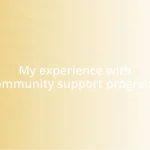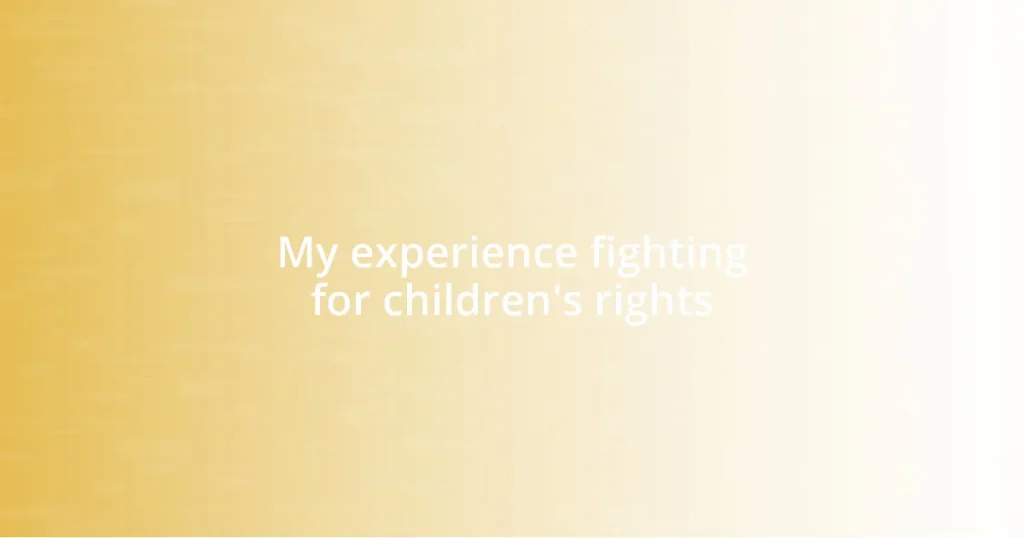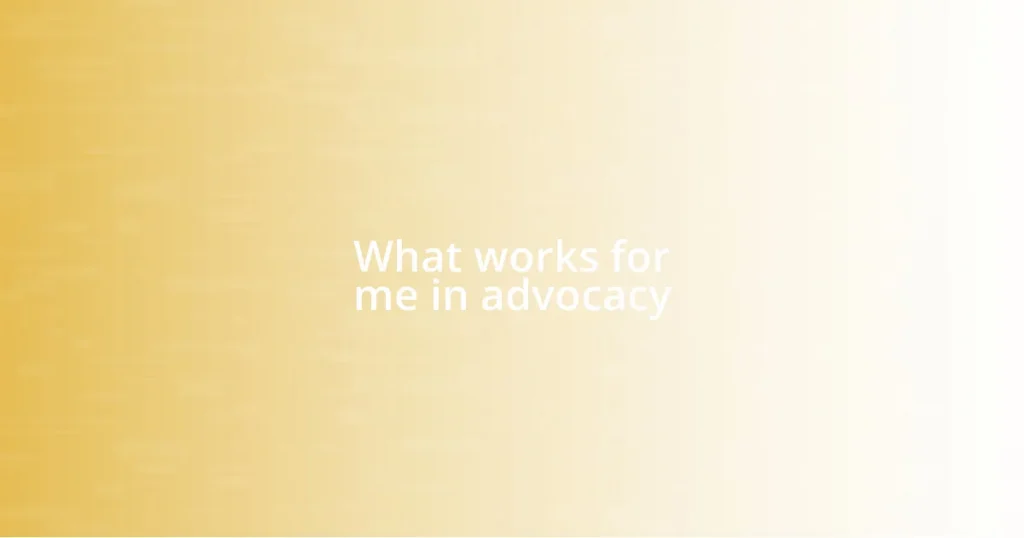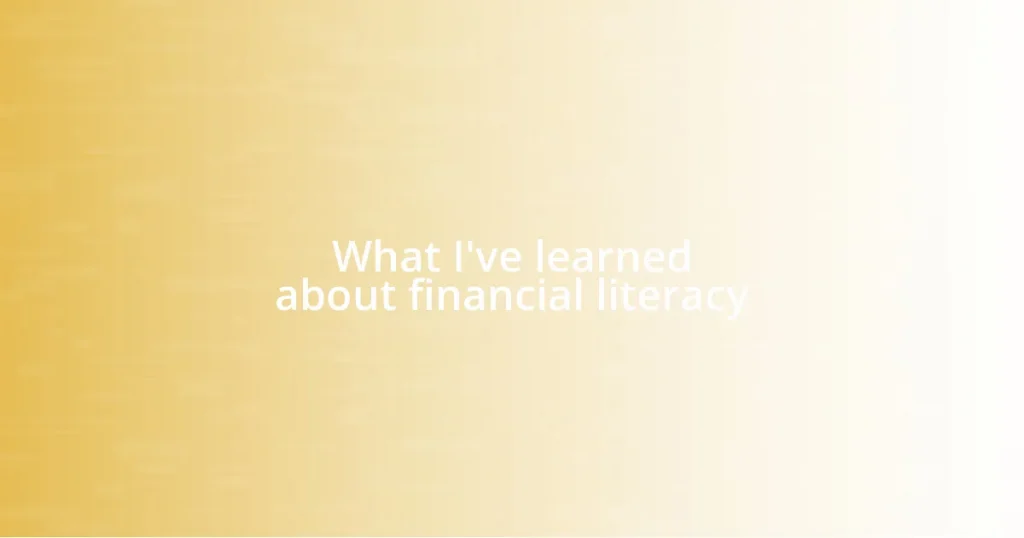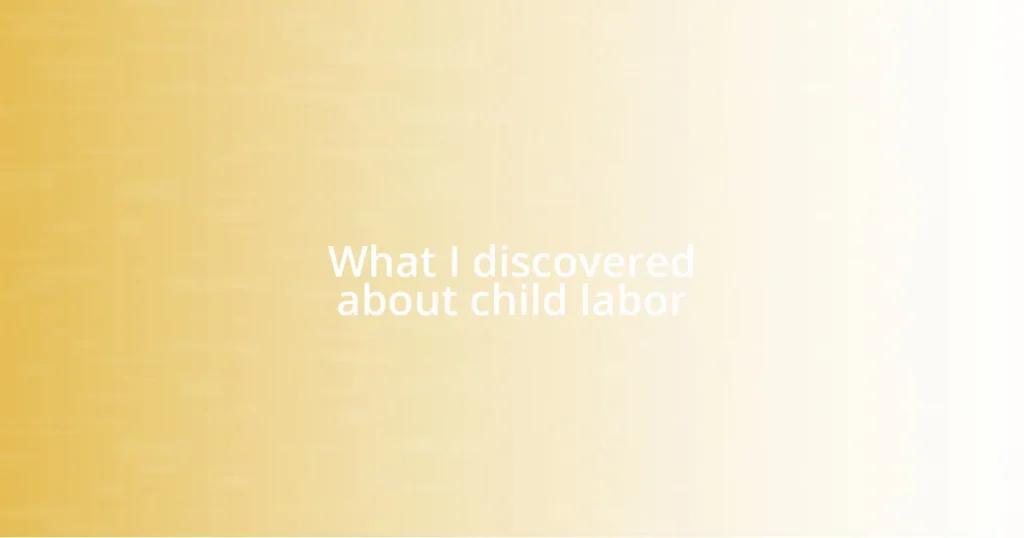Key takeaways:
- Children have specific rights under international law, emphasizing the need for empowerment and awareness to ensure their well-being.
- Engaging personal stories can significantly impact advocacy efforts by transforming abstract policy issues into relatable experiences.
- Collaborative efforts with organizations enhance community support and facilitate resource sharing for children’s rights initiatives.
- Achieving tangible changes requires addressing both immediate needs, like clothing drives, and systemic issues, such as mental health support in schools.

Understanding children’s rights
Understanding children’s rights is fundamental to ensuring their well-being and development. I remember attending a local community meeting where a concerned parent passionately shared her story about her child being denied access to adequate education. It struck me then how essential it is for society to recognize that every child has the right to learn and grow in a supportive environment.
When I first delved into the topic, I was surprised to discover that children hold specific rights under international law, such as the UN Convention on the Rights of the Child. Can you imagine a world where every child’s voice is heard and respected? That thought alone inspires me. Our responsibility as adults is to advocate for these rights, standing up for those who often feel powerless.
The notion of children’s rights extends far beyond mere legal frameworks; it embodies the idea of nurturing potential and fostering dignity. I vividly recall a school visit where I saw children engaged in a vibrant discussion about their rights. Their enthusiasm reminded me that when children understand their rights, they are more empowered to claim them. This interaction not only enlightened me but also deepened my belief that promoting awareness of these rights is crucial for building a just society.

My motivation to advocate
My motivation to advocate for children’s rights stems from deeply personal experiences that shaped my understanding of their struggles. One memory stands out—a schoolyard conversation with a young girl who shared that she often felt invisible in her classroom. Listening to her, I felt an overwhelming urge to ensure that no child experiences the isolation she described. That moment ignited my commitment to advocate for those who may not have the power to voice their needs.
- Witnessing children face barriers to education and healthcare fuels my passion.
- Personal stories of resilience inspire me to fight for change.
- Knowing that my advocacy could help a child reclaim their voice drives my actions.
- Each child’s unique experience reinforces the importance of tailored support in advocacy work.

Building awareness in communities
Building awareness in communities is essential for fostering support for children’s rights. I recall a weekend community fair where I set up a booth dedicated to informing locals about the significance of children’s rights. Engaging with parents and caregivers, I shared powerful stories and statistics that illuminated the everyday challenges children face. It was rewarding to see how a simple conversation could ignite awareness and prompt questions about what we can all do to support the younger generation.
Often, awareness is the first step toward action. I remember a local workshop where we facilitated discussions on children’s rights, including their right to play and learn. Seeing participants connect their own experiences to these rights created a ripple effect. They began to share their struggles, leading to collaborative solutions that we could all implement in our community. It’s moments like these that affirm my belief that knowledge truly empowers.
The impact of building awareness translates into tangible change. One vivid instance stands out to me: after hosting an educational session at a neighborhood community center, I saw a group of parents rally together to support a child who was facing discrimination at school. The tears of gratitude from that child’s family reinforced the profound change that community awareness can inspire. With every story shared and every conversation sparked, we take steps closer to ensuring every child’s rights are acknowledged and upheld.
| Awareness Strategy | Impact on the Community |
|---|---|
| Community Workshops | Fosters dialogue and solution-sharing among locals. |
| Informational Booths | Increases engagement and educates parents about children’s rights. |
| Storytelling Events | Builds empathy and connects personal experiences to broader issues. |

Engaging with policymakers effectively
Engaging with policymakers effectively requires not just knowledge but also a strategic approach. During a meeting with a local legislator, I shared the story of a child who couldn’t access basic healthcare because of outdated policies. As I spoke, I could see their expression change—what started as indifference turned into genuine concern. Isn’t it fascinating how a personal story can bridge that gap and make the problem feel real?
Establishing relationships with policymakers is equally important. I remember attending a small-town council session, where I took the opportunity to chat informally with some members. We discussed local needs over coffee, and I shared insights from my advocacy work, which led to them inviting me to speak at future forums. These moments of connection often pave the way for more meaningful dialogues—after all, who doesn’t appreciate a face behind the issues they’re working to address?
Finally, persistence plays a crucial role. I’ve often found myself following up with policymakers after initial meetings, sending them emails that highlight ongoing challenges based on new data or a recent child’s story that resonates. Each follow-up is an opportunity to remind them of the impact their decisions have on vulnerable lives. How can we expect change if we don’t keep the conversation going? By staying engaged, we cultivate a sense of accountability and urgency that can drive real transformations in children’s lives.

Collaborating with organizations
Collaborating with organizations has been a game changer in my fight for children’s rights. I remember when I first reached out to a local nonprofit focused on youth advocacy. They welcomed me with open arms, and together we organized a campaign to raise funds for educational resources for underprivileged children. Seeing our combined efforts lead to a tangible outcome felt incredibly empowering, proving that partnership amplifies our impact.
Working with diverse organizations allows for sharing resources and expertise that can be invaluable. One time, I partnered with a legal aid organization to provide free workshops for parents about their children’s rights regarding education. I was blown away by the turnout and the grateful feedback. It was a heartwarming reminder that when organizations come together, the community truly thrives. Isn’t it amazing how collaboration can turn a simple workshop into a lifeline for families seeking support?
Every collaboration offers a unique perspective that enriches our understanding of the issues at hand. During a joint initiative with an organization focused on mental health, I discovered just how intertwined children’s rights are with their emotional well-being. Through discussions and activities, we not only raised awareness but also built a network that continues to support families today. How valuable is it to connect the dots in this way? The lessons learned reinforce my conviction that, united, we can tackle even the most daunting challenges facing our children.

Sharing personal stories for impact
Sharing personal stories can be a powerful tool for driving impact in advocacy. I recall a heartfelt moment when I shared a personal story during a community meeting about the challenges a friend’s child faced in the foster care system. As I spoke, the room silenced, and I watched as parents began nodding in understanding. It dawned on me how our individual experiences could weave a tapestry of empathy that moved others to take action. Have you ever noticed how vulnerability can spark a connection that facts alone cannot?
What truly struck me was the way personal narratives transformed the perception of policy issues from abstract to urgent. I once met with a group of students advocating for mental health resources in schools, and one young girl bravely recounted her struggles with anxiety. Her story resonated deeply with everyone in attendance, illustrating a shared reality that often feels invisible. This collective acknowledgment not only inspired action but made the issue relatable, reminding us all that we are not alone in our struggles.
In my experience, the emotional weight of a personal story often lingers long after the words are spoken. One time, I recounted the journey of a young boy I mentored, who found his voice through art despite systemic barriers. Those listening were moved, and I could see seeds of passion being planted. Isn’t it fascinating how these moments of shared humanity can motivate others to join the fight for change? The stories we share have the potential to uplift, inspire, and galvanize action in ways that mere statistics simply cannot achieve.

Achieving tangible changes for children
Achieving tangible changes for children often comes down to identifying specific needs and taking direct action. I vividly remember a particular winter when local schools reached out for help providing warm clothing for children who didn’t have adequate winter attire. It was heartbreaking to think about children shivering as they walked to school. With the community’s support, we organized a clothing drive that exceeded our expectations. Seeing those kids bundle up in jackets and hats donated by caring neighbors made that effort feel profoundly rewarding.
Beyond immediate needs, addressing systemic issues is crucial for long-term change. I once participated in a local council meeting where we uncovered gaps in mental health services for children. It struck me how discussions led to the proposal of a dedicated fund for mental health support in schools. The thought that our dialogue could blossom into structured support for vulnerable students left me inspired. How often do we overlook the power of our voices in these discussions?
Every small victory fuels the fire of advocacy. I was involved in outreach for a summer reading program aiming to improve literacy rates among kids in underserved areas. The joy on their faces when they received brand-new books was a reminder that even simple interventions can inspire a love for learning. It’s moments like these that remind me: tangible changes for children aren’t just about policies—they’re about hitting the ground running and making life better one child at a time. Isn’t it incredible to think about the ripples of change we can create when we come together for a common goal?






